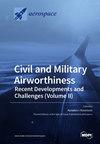Tailoring 3D Star-Shaped Auxetic Structures for Enhanced Mechanical Performance
IF 2.1
3区 工程技术
Q2 ENGINEERING, AEROSPACE
引用次数: 0
Abstract
Auxetic lattice structures are three-dimensionally designed intricately repeating units with multifunctionality in three-dimensional space, especially with the emergence of additive manufacturing (AM) technologies. In aerospace applications, these structures have potential for use in high-performance lightweight components, contributing to enhanced efficiency. This paper investigates the design, numerical simulation, manufacturing, and testing of three-dimensional (3D) star-shaped lattice structures with tailored mechanical properties. Finite element analysis (FEA) was employed to examine the effect of a lattice unit’s vertex angle and strut diameter on the lattice structure’s Poisson’s ratio and effective elastic modulus. The strut diameter was altered from 0.2 to 1 mm, while the star-shaped vertex angle was adjusted from 15 to 90 degrees. Laser powder bed fusion (LPBF), an AM technique, was employed to experimentally fabricate 3D star-shaped honeycomb structures made of Ti6Al4V alloy, which were then subjected to compression testing to verify the modelling results. The effective elastic modulus was shown to decrease when increasing the vertex angle or decreasing the strut diameter, while the Poisson’s ratio had a complex behaviour depending on the geometrical characteristics of the structure. By tailoring the unit vertex angle and strut diameter, the printed structures exhibited negative, zero, and positive Poisson’s ratios, making them applicable across a wide range of aerospace components such as impact absorption systems, aircraft wings, fuselage sections, landing gear, and engine mounts. This optimization will support the growing demand for lightweight structures across the aerospace sector.定制三维星形辅助结构以增强机械性能
增材制造(AM)技术的兴起,使辅晶格结构成为在三维空间中具有多功能性的三维设计复杂重复单元。在航空航天应用中,这些结构有望用于高性能轻质部件,从而提高效率。本文研究了具有定制机械性能的三维(3D)星形晶格结构的设计、数值模拟、制造和测试。本文采用有限元分析(FEA)来研究晶格单元的顶角和支柱直径对晶格结构泊松比和有效弹性模量的影响。支杆直径从 0.2 毫米到 1 毫米不等,星形顶角从 15 度到 90 度不等。实验采用激光粉末床熔融技术(LPBF)制造了由 Ti6Al4V 合金制成的三维星形蜂窝结构,并对其进行了压缩测试,以验证建模结果。结果表明,当顶点角增大或支柱直径减小时,有效弹性模量会减小,而泊松比则因结构的几何特征而表现复杂。通过调整单位顶点角和支柱直径,打印结构呈现出负泊松比、零泊松比和正泊松比,使其适用于广泛的航空航天组件,如冲击吸收系统、飞机机翼、机身部分、起落架和发动机支架。这一优化将满足航空航天领域对轻质结构日益增长的需求。
本文章由计算机程序翻译,如有差异,请以英文原文为准。
求助全文
约1分钟内获得全文
求助全文
来源期刊

Aerospace
ENGINEERING, AEROSPACE-
CiteScore
3.40
自引率
23.10%
发文量
661
审稿时长
6 weeks
期刊介绍:
Aerospace is a multidisciplinary science inviting submissions on, but not limited to, the following subject areas: aerodynamics computational fluid dynamics fluid-structure interaction flight mechanics plasmas research instrumentation test facilities environment material science structural analysis thermophysics and heat transfer thermal-structure interaction aeroacoustics optics electromagnetism and radar propulsion power generation and conversion fuels and propellants combustion multidisciplinary design optimization software engineering data analysis signal and image processing artificial intelligence aerospace vehicles'' operation, control and maintenance risk and reliability human factors human-automation interaction airline operations and management air traffic management airport design meteorology space exploration multi-physics interaction.
 求助内容:
求助内容: 应助结果提醒方式:
应助结果提醒方式:


